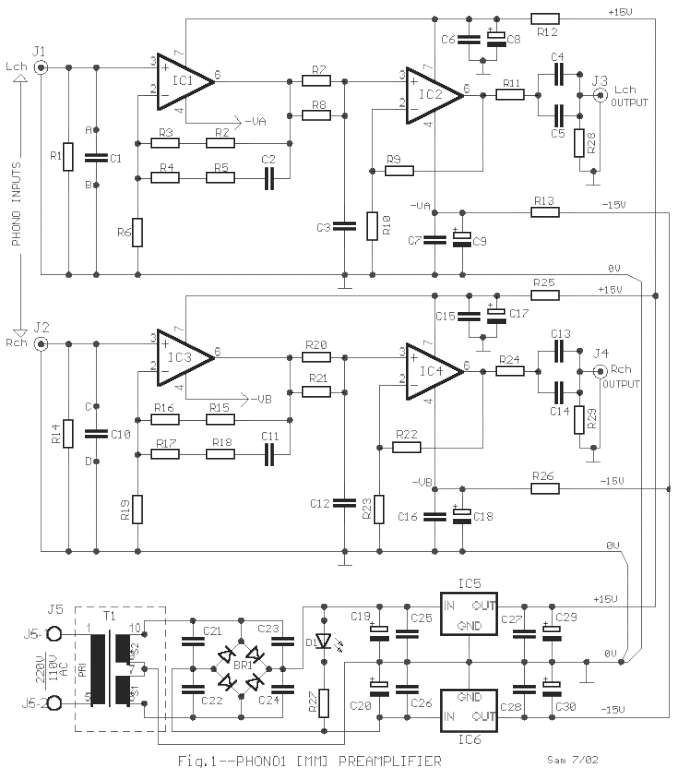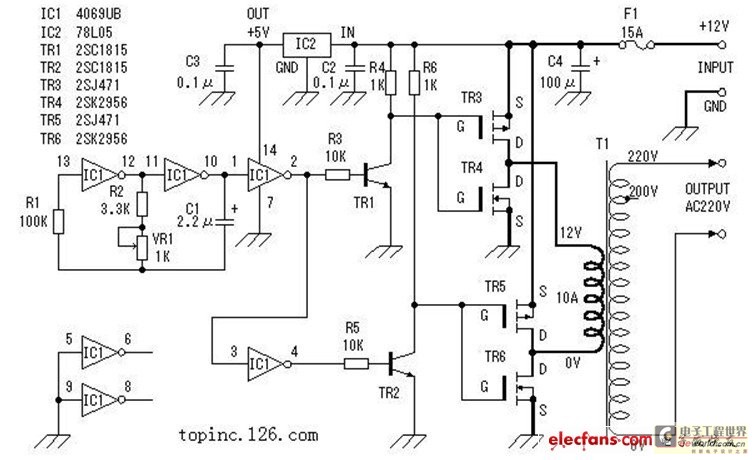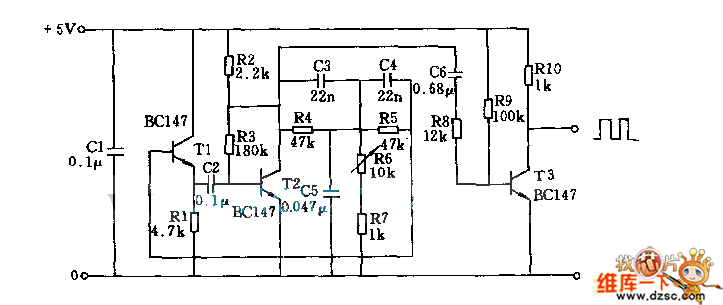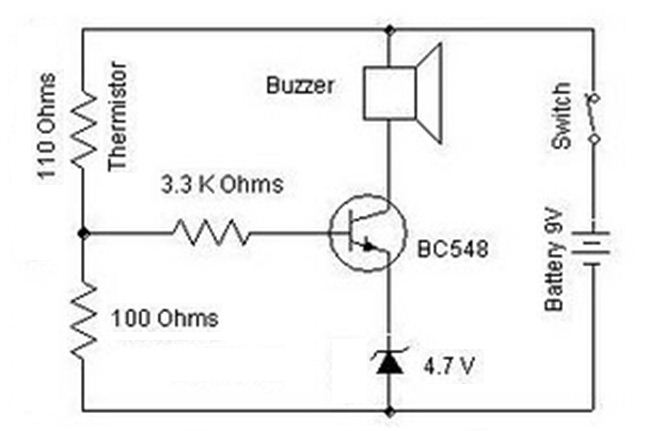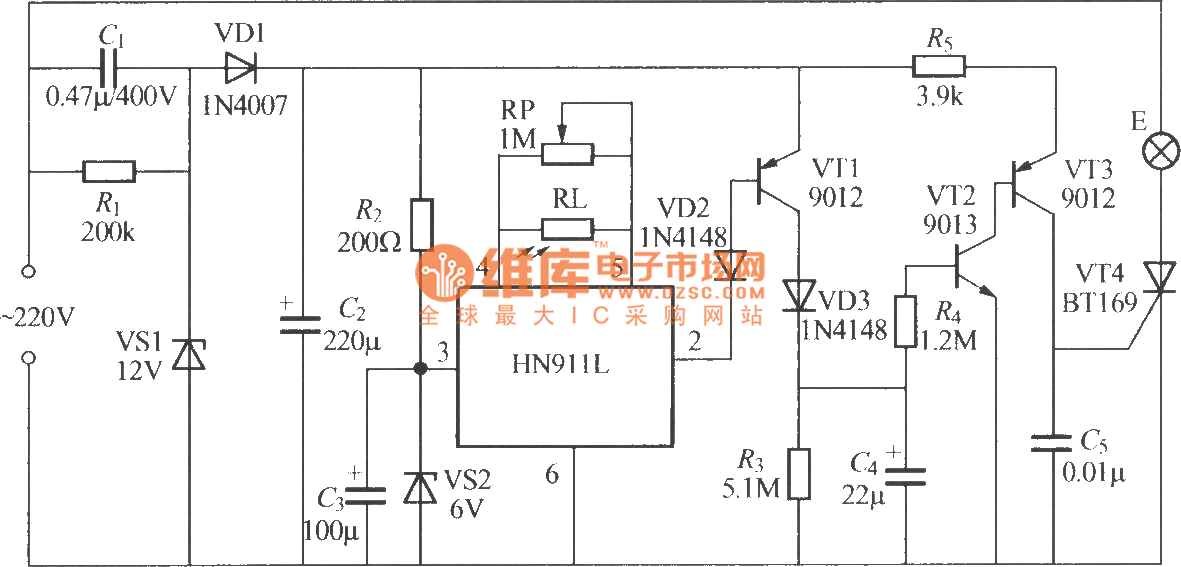
Miniature Wideband Amplifier Circuit
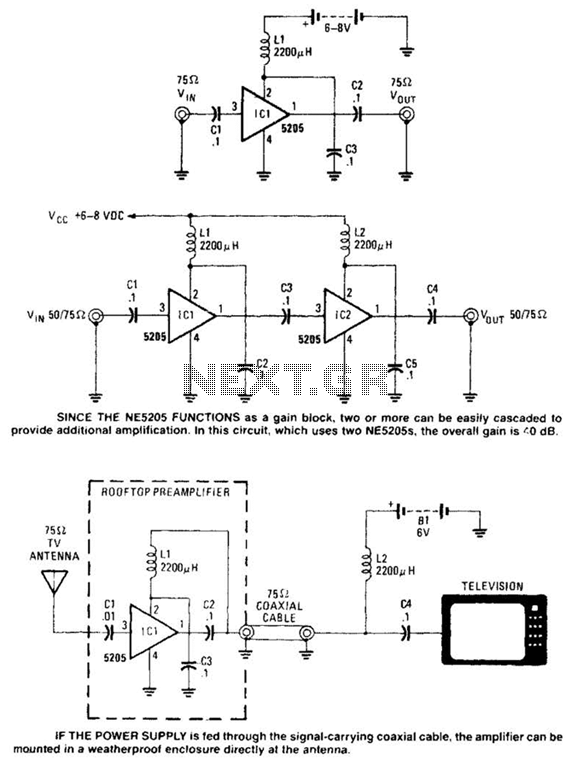
Except for the coupling and decoupling capacitors, IC1 is a complete wideband amplifier that has a fixed gain of 20 dB up to 450 MHz. No external compensation is required. Since the NE5205 functions as a gain block, two or more can be easily cascaded to provide additional amplification. In this circuit, which uses two NE5205S, the overall gain is 40 dB. If the power supply is fed through the signal-carrying coaxial cable, the amplifier can be mounted in a weatherproof enclosure directly at the antenna.
The NE5205 wideband amplifier is designed for applications requiring high-frequency performance and stable gain. The fixed gain of 20 dB across a frequency range of up to 450 MHz makes it suitable for various RF applications, including signal amplification in communication systems. The internal design of the NE5205 allows for easy cascading, enabling multiple amplifiers to be connected in series to achieve higher overall gains without the need for complex external compensation circuits.
In the described configuration using two NE5205S amplifiers, the overall gain is effectively doubled to 40 dB, enhancing the system's capability to amplify weak signals received by the antenna. This cascading setup is particularly advantageous in scenarios where maintaining signal integrity is critical, such as in long-distance communication or in environments with significant signal attenuation.
The implementation of coupling and decoupling capacitors is essential in this circuit to ensure proper signal transmission while filtering out unwanted noise and preventing DC bias from affecting the performance of the amplifiers. These capacitors allow AC signals to pass while blocking DC components, thereby maintaining the integrity of the amplified signal.
Furthermore, the option to power the amplifier through the signal-carrying coaxial cable simplifies installation and reduces the need for additional power lines, making it feasible to deploy the amplifier directly at the antenna site. Utilizing a weatherproof enclosure ensures that the amplifier remains protected from environmental factors, thus enhancing its reliability and longevity in outdoor applications. This design consideration is critical for maintaining consistent performance in various weather conditions, making it an optimal choice for outdoor RF applications. Except for the coupling and decoupling capacitors, IC1 is a complete wideband amplifier that has a fixed gain of 20 dB to 450 MHz. No external compensation is required. since the NE5205 functions as a gain block, two or more cart be easily cascaded to provide additional amplification.
In this circuit, which uses two NE5205S, the overall gain is 40 dB. JF the power supply is fed through the signal-carrying coaxial cable, the amplifier can be mounted in a weatherproof enclosure directly at the antenna. 🔗 External reference
The NE5205 wideband amplifier is designed for applications requiring high-frequency performance and stable gain. The fixed gain of 20 dB across a frequency range of up to 450 MHz makes it suitable for various RF applications, including signal amplification in communication systems. The internal design of the NE5205 allows for easy cascading, enabling multiple amplifiers to be connected in series to achieve higher overall gains without the need for complex external compensation circuits.
In the described configuration using two NE5205S amplifiers, the overall gain is effectively doubled to 40 dB, enhancing the system's capability to amplify weak signals received by the antenna. This cascading setup is particularly advantageous in scenarios where maintaining signal integrity is critical, such as in long-distance communication or in environments with significant signal attenuation.
The implementation of coupling and decoupling capacitors is essential in this circuit to ensure proper signal transmission while filtering out unwanted noise and preventing DC bias from affecting the performance of the amplifiers. These capacitors allow AC signals to pass while blocking DC components, thereby maintaining the integrity of the amplified signal.
Furthermore, the option to power the amplifier through the signal-carrying coaxial cable simplifies installation and reduces the need for additional power lines, making it feasible to deploy the amplifier directly at the antenna site. Utilizing a weatherproof enclosure ensures that the amplifier remains protected from environmental factors, thus enhancing its reliability and longevity in outdoor applications. This design consideration is critical for maintaining consistent performance in various weather conditions, making it an optimal choice for outdoor RF applications. Except for the coupling and decoupling capacitors, IC1 is a complete wideband amplifier that has a fixed gain of 20 dB to 450 MHz. No external compensation is required. since the NE5205 functions as a gain block, two or more cart be easily cascaded to provide additional amplification.
In this circuit, which uses two NE5205S, the overall gain is 40 dB. JF the power supply is fed through the signal-carrying coaxial cable, the amplifier can be mounted in a weatherproof enclosure directly at the antenna. 🔗 External reference
